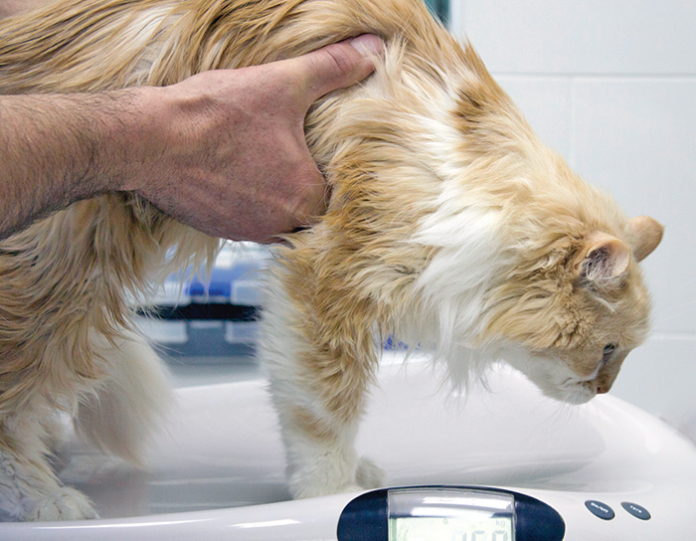Hyperthyroidism is a common condition in older cats. Symptoms include weight loss, muscle wasting, increased appetite, increased thirst and urination, vomiting, unkempt appearance, and sometimes hyperactivity. You may feel a lump on your cat’s throat under his jaw.
In 98% of cases, that thyroid-gland enlargement is the result of a non-cancerous tumor called an adenoma. (Thyroid carcinoma is found in 2% of cats. About 70% of cats have both lobes of the thyroid gland affected.) When the thyroid gland becomes enlarged, it can go into overdrive and produce too much thyroxine, which is the hormone commonly called T4. Thyroxine is important in metabolism and an increased production of T4 is what causes the signs of feline hyperthyroidism.
Combatting Weight Loss
Hyperthyroid cats break down the protein in their own muscles to fuel their bodies’ increased metabolism. Cats suffering from hyperthyroidism can become emaciated if not diagnosed and treated promptly.
Tell your veterinarian which food(s) you are feeding and how much you are feeding so that he or she can ensure that the diet should help your cat gain weight and muscle mass while medical treatment is started. Any dietary changes made at this point will likely need to be continued even after your cat’s thyroid hormone levels have normalized, because it can take months to rebuild lost muscle mass.
The 2014 article “Dietary Management of Feline Endocrine Disease,” published in Veterinary Clinics of North America: Small Animal Practice, was co-authored by Mark E. Peterson, DVM, Dip. ACVIM, director of the Animal Endocrine Clinic in New York City and adjunct Professor of Medicine at the New York State College of Veterinary Medicine, Cornell University and Cornell graduate Laura Eirmann, DVM, Dip. ACVN.
In this article, Dr. Peterson and Dr. Eirmann recommend that the ideal diet for a hyperthyroid cat should be relatively high in high quality protein and low in carbohydrates. It also should be low in phosphates if the cat has or is at risk for kidney disease, which is common in older cats and is often diagnosed in those with hyperthyroidism.
Protein and Carbs
Dr. Peterson and Dr. Eirmann recommend that a hyperthyroid cat’s diet should be 40% protein. This high protein concentration is recommended because hyperthyroid cats often suffer from sarcopenia (muscle loss) for two reasons: age-related changes and the increased metabolism caused by hyperthyroidism.
Senior cats also don’t digest protein as readily as younger cats, so it is important to provide lots of easily digested protein from animal sources. Look for meat or meat byproducts among the top five listed ingredients, and keep in mind that canned food generally has higher protein content than dry food. Canned food also increases your cat’s water intake.
A diet with less than 15% carbohydrates is recommended to help stabilize the cat’s blood glucose levels around mealtimes, which is beneficial because hyperthyroid cats can develop diabetes. Again, canned food is usually a better fit than dry food.
Carb percentages aren’t standard on cat food labels, but they’re easy to figure out: “Add the percentages listed on the label for protein, fat, fiber, moisture and ash. Ignore the other listed amounts, as these will be for minerals included in the ash percentage or be so small as to not affect the calculation. Subtract this number from 100 to get the carb percentage on a wet matter basis,” says feline-nutrition.org.
Keep in mind that low-carb diets often contain a high percentage of fat. This is great for underweight cats who need the extra energy to regain weight, but it means that you will need to monitor your cat’s weight as his health stabilizes to make sure he does not become overweight.
Iodine Restriction
Iodine, an essential nutrient that must be supplied in the cat’s diet, is required to produce thyroxine; and one treatment option for feline hyperthyroidism is the restriction of dietary iodine.
Hill’s Y/D Prescription Diet is an iodine-restricted diet, and studies have shown that this diet can help to maintain normal thyroid hormone levels in hyperthyroid cats. In some cases, though, it may not resolve all the clinical symptoms. Dr. Peterson and Dr. Eirmann have expressed concern that Y/D diet (particularly the dry formula) may not be nutritionally complete and balanced for long-term use, but it can be a useful option for owners who do not wish to pursue radioactive iodine therapy and for cats that do not tolerate methimazole (a drug commonly used to treat feline hyperthyroidism).
Most importantly, for this diet to be effective, it must be the only thing that the cat eats. Any treats, table scraps, or food stolen from another pet may result in increased dietary intake of iodine, precluding effectiveness of this treatment option.
The health effects of an iodine-restricted diet in cats with normal thyroid levels have not been determined, so Y/D should not be fed to a healthy cat with normal thyroid levels.
Treatments
The Cornell Feline Health Center highlights several treatment options for hyperthyroid cats:
- Radioactive iodine therapy (the current gold-standard treatment)
- Methimazole therapy
- Dietary iodine restriction
- Surgical removal of the thyroid gland (not commonly pursued)
For more information, go to https://tinyurl.com/FelineHealthCenterHyperthyroid




